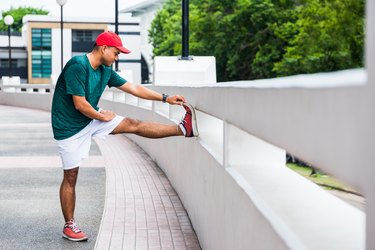
Stems. Gams. Stumps. Whatever you call them, the legs are where a lot of people tend to store extra padding. And while it's not possible to target weight loss to just one area of the body, there are diet and exercise tweaks you can make to help slim down your legs fast.
Just like blue eyes and wavy hair are inherited, body types are also passed down from your parents: "People genetically have different body types, and we cannot change that," Hannah Davis, certified strength and conditioning specialist and founder of Body by Hannah, tells LIVESTRONG.com.
Video of the Day
Video of the Day
At the genetic level, you may be more prone to gaining fat in one area of the body. "For example, a pear-shaped body type will generally gain weight in the legs first and the midsection last," Davis says.
Your sex also plays a role. "Upper body fat is more common in [people assigned male at birth (AMAB)], whereas [people assigned female at birth (AFAB)] tend to hold fat in their hips, thighs, buttocks, lower abdominal area and the back of the upper arms," says Jonathan Valdez, RDN, owner of Genki Nutrition and spokesperson for the New York State Academy of Nutrition and Dietetics.
Here, learn why targeted spot-reduction workouts aren't effective and get the best diet and exercise advice to slim your thighs and calves (while supporting your total body wellness).
Why Targeted Exercises Are a Losing Battle
First, it's important to remember there's no magical best way to slim legs. Try as you might, doing hundreds of leg lifts isn't going to help you quickly trim down your legs in the way you might imagine.
"Spot reduction is the idea that you can target a specific area in your body to lose fat, but unfortunately, most research has proven this not to be true," says dietitian Nicole Hinckley, RD. "When you lose fat, triglycerides are broken down into free fatty acids and glycerol, and these components can come from anywhere in the body and then enter the bloodstream to be used as fuel."
In other words, leg exercises don't really cause you to lose fat from your legs.
Case in point: In an August 2013 study in the Journal of Strength and Conditioning Research, researchers had people intensely exercise their non-dominant leg three times per week. After 12 weeks, no notable fat changes occurred in either leg, but some fat loss was reported in the upper body.
So instead of concentrating all your effort into your legs, below, explore what you should try instead.
Related Reading
1. Do Full-Body Workouts
Working out your lower body is a great idea for building muscle and improving your endurance, but focusing only on exercises that target your legs isn't the best idea.
"The best program for weight loss and toning is a balanced, full-body strength-training program with moderate cardio to burn calories and build muscle throughout the entire body," Davis says.
2. Create a Cardio Routine
Speaking of cardio, the Physical Activity Guidelines for Americans recommend working out at a moderate intensity (think: jogging or brisk walking) for 150 minutes a week, which can break down to 30 minutes a day, five times a week.
You can shorten this to 75 minutes a week if you hit the gym a little harder and exercise more vigorously, but don't overdo it if you're relatively new to working out.
The following are great physical activities that won't directly burn leg fat, but will burn calories and contribute to greater leg strength and muscle tone:
- Jogging
- Bicycling
- Hiking
- Stair climbing
- Running or walking in sand
- Swimming
- Barre workouts
- Pilates
3. Don't Skip Strength Training
Be sure to strength train to build lean muscle and support fat loss, too. Davis suggests these moves for clients who are looking to get slimmer legs.
- Front squats
- Deadlifts
- Reverse lunges
"These will build muscle in every part of the lower body," she says.
Per Harvard Health Publishing, strength training helps you maintain and even increase muscle mass, which is typically lost as we age. Replacing fat with muscle means your body will naturally burn more calories and look leaner.
And remember, you don't even need a real gym to focus on leg exercises. According to the Mayo Clinic, just walking up a set of stairs can help you get toned, lean legs.
Looking for a Beginner-Friendly Full-Body Routine?
Check out these two workouts that target every major muscle group. Bonus: You can do them in your living room.
4. Try Balance Exercises
Balance training is often overlooked in fitness routines. But it's an important way to build mobility, improve exercise form and strengthen your muscles, according to the American Council on Exercise (ACE).
Dynamic balance training in particular can strengthen and tone the muscles in your legs, core and back, per the ACE, which is why it can help slim down legs. Try balancing exercises such as:
- Lunge matrix
- Speed skaters
- Bird-dogs
- Pendulum lunges
5. Stretch Often
Stretching is another important part of any well-rounded exercise program.
That's because regular stretching can help improve flexibility, increase range of motion and reduce your risk for injury, according to the Mayo Clinic. And when it comes to how to slim your legs, those benefits can help lengthen and tone your muscles.
6. Eat Nutritious Foods
Exercise isn't the only component of total wellbeing — diet is also important. That's because eating plenty of nutritious foods can help you find your ideal weight, according to the 2020-2025 Dietary Guidelines for Americans, which may help you get smaller legs.
Per the guidelines, include these foods in your diet:
- Fruits and vegetables
- Whole grains like brown rice, wheat bread and oatmeal
- Fat-free or low-fat dairy products like milk and yogurt
- Protein sources like seafood, lean meats, poultry and eggs
- Legumes like lentils, beans and peas
- Soy products like tofu and tempeh
- Nuts and seeds
At the same time, the Dietary Guidelines for Americans recommend limiting or avoiding the following ingredients:
- Saturated and trans fats
- Salt (sodium)
- Added sugars
Ready to Lose Weight?
Set yourself up for success with LIVESTRONG.com's Weight-Loss Kickstart program.
7. Don't Forget Protein and Fiber
Studies have shown that a high-protein, low-fat and high-fiber diet may be most effective in weight loss and maintenance, Valdez says.
As for specific ways to eat and which foods to focus on for weight loss, Hinckley recommends eating every three to four hours and pairing a complex carbohydrate with a lean protein and beneficial fat. "Make sure you get enough protein to help maintain muscle mass and add in veggies whenever you can," she says.
According to a December 2019 meta-analysis in Advances in Nutrition, those who are strength training or cutting calories for weight loss should aim to get 1.3 grams of protein per kilogram of body weight (1 kilogram equals 2.2 pounds).
So, for example, a 200-pound person who is trying to lose weight should aim to eat about 118 grams of protein a day. (To put that into perspective, a 4-ounce serving of chicken breast has about 27 grams of protein, per the USDA.)
8. Cut Calories Safely for Weight Loss

"Eat less, move more" is the age-old adage for weight loss, but doing it safely is paramount. Trying to lose weight too quickly by resorting to extreme dieting isn't safe or sustainable.
According to the Centers for Disease Control and Prevention, your best weight-loss goal is a pound or two per week. One pound is equal to about 3,500 calories, Hinckley says, so aim to subtract 500 calories per day from your diet to lose a pound per week.
Just keep in mind that you shouldn't dip below 1,200 calories a day for people AFAB or 1,500 for people AMAB to stay healthy, per Harvard Health Publishing.
"A safe and effective calorie deficit will usually consist of a reduction in dietary calories along with an increase in the number of calories burned via exercise," Valdez says.
9. Drink Plenty of Water
Good hydration is key to keeping your body functioning at its best — getting enough water helps regulate your temperature, keep joints lubricated, support organ function and provide nutrients to your body's cells, according to the Harvard T.H. Chan School of Public Health.
Hydration also plays a role in maintaining healthy muscle tissue and performance, per August 2019 research in Nutrients. Without it, your muscles may not be able to function well, which can compromise both your exercise routine and overall wellbeing. So when it comes to how to slim your legs, don't skimp on the fluids.
How Much Water Should You Drink?
Use this equation to determine how much water you should drink every day:
Body weight (in pounds) ÷ 2 = minimum ounces of water you should drink per day.
10. Try Not to Rush the Process
Your #goal for slim legs may feel super important, especially if you're planning a cruise or beach vacation in the near future. But keep in mind that the thighs, hips and buttocks can be stubborn places of fat storage.
Losing weight too quickly can backfire, and overtraining may lead to injury, per the Mayo Clinic. So take it slow: Stick to a manageable calorie deficit and ease into a fitness routine that works for you, and you will see results.
The Bottom Line
In order to get thinner thighs and calves, you'll need to do regular cardio exercises and strength train to build and tone your muscles. If you want skinnier legs, you'll need to cut your calories and watch your diet to lose fat, too.
Keep in mind, though, that genetics play a role in how your body stores fat and what your legs look like, so try not to chase an unrealistic or unhealthy appearance. Instead, make healthy choices when it comes to diet and exercise, and remember that healthy living is a marathon, not a sprint.
- Journal of Strength and Conditioning Research: "Regional Fat Changes Induced By Localized Muscle Endurance Resistance Training"
- Harvard Health Publishing: "Add strength training to your fitness plan"
- Mayo Clinic: "Step it up: 7 quick stair exercises to do at home"
- U.S. Department of Health and Human Services: "Physical Activity Guidelines for Americans"
- USDA FoodData Central: "Chicken Breast"
- U.S. Department of Agriculture and U.S. Department of Health and Human Services: "2020-2025 Dietary Guidelines for Americans"
- Mayo Clinic: "Mayo Clinic Minute: The benefits of stretching"
- American Council on Exercise: "Dynamic Balance | 5 Benefits of Training for Dynamic Balance"
- Harvard T.H. Chan School of Public Health: "The importance of hydration"
- Nutrients: "The Role of Water Homeostasis in Muscle Function and Frailty: A Review"
- Advances in Nutrition: "Protein Intake Greater than the RDA Differentially Influences Whole-Body Lean Mass Responses to Purposeful Catabolic and Anabolic Stressors: A Systematic Review and Meta-analysis"
- Harvard Health Publishing: "Calorie counting made easy"
- Centers for Disease Control and Prevention: "Losing Weight"
- American Council on Exercise: Summer Boot Camp: Legs Workout


